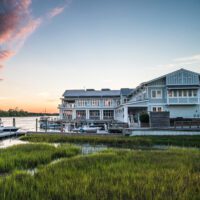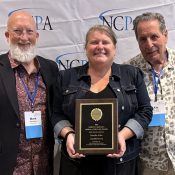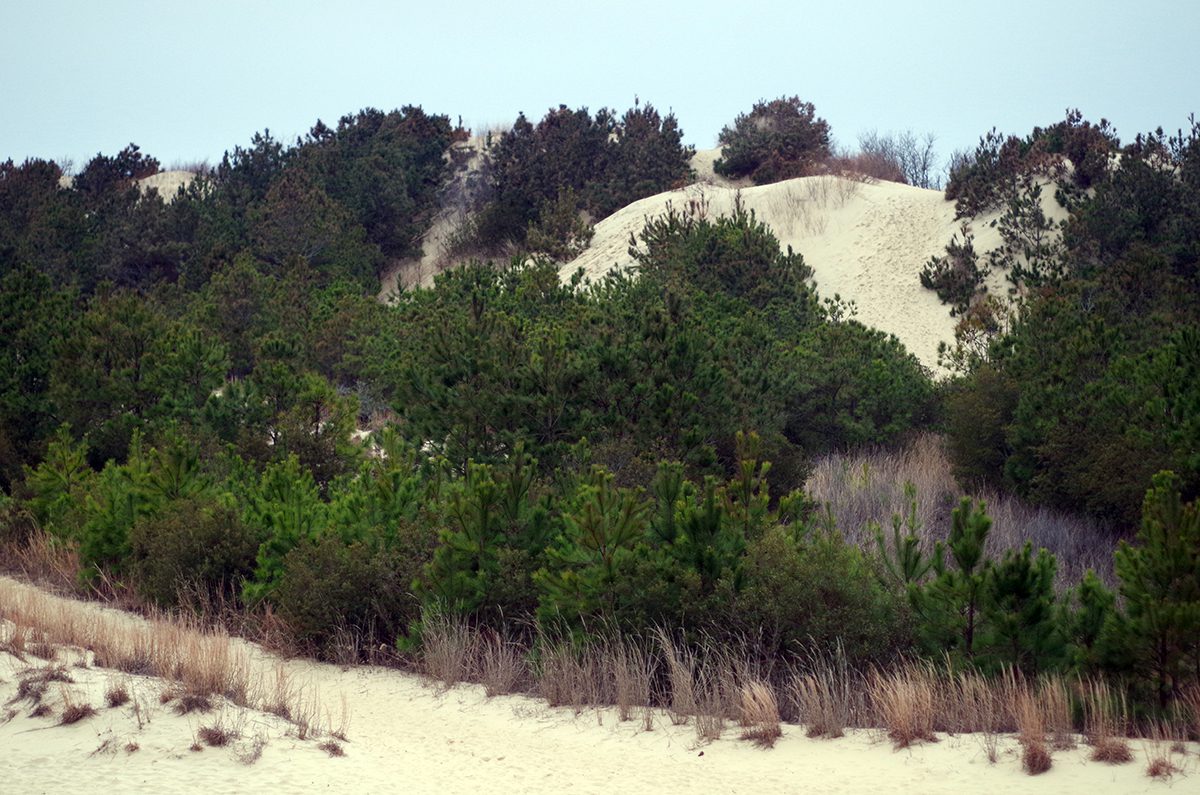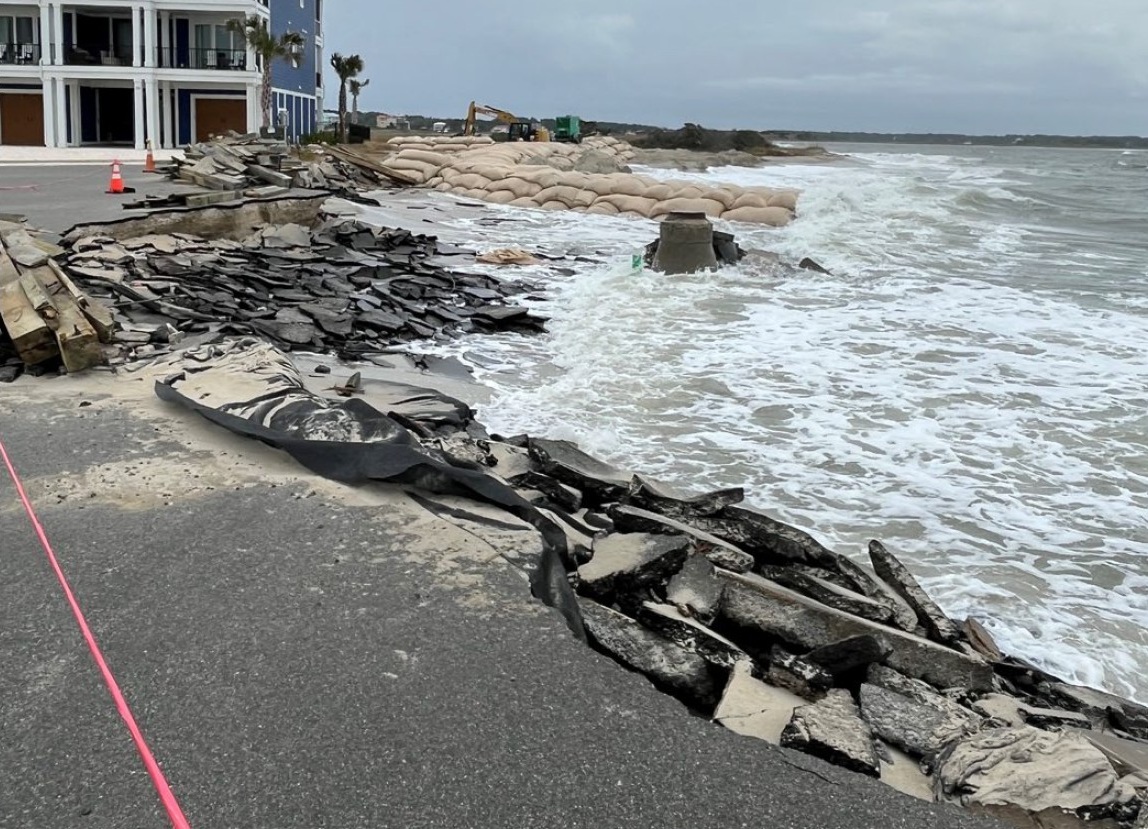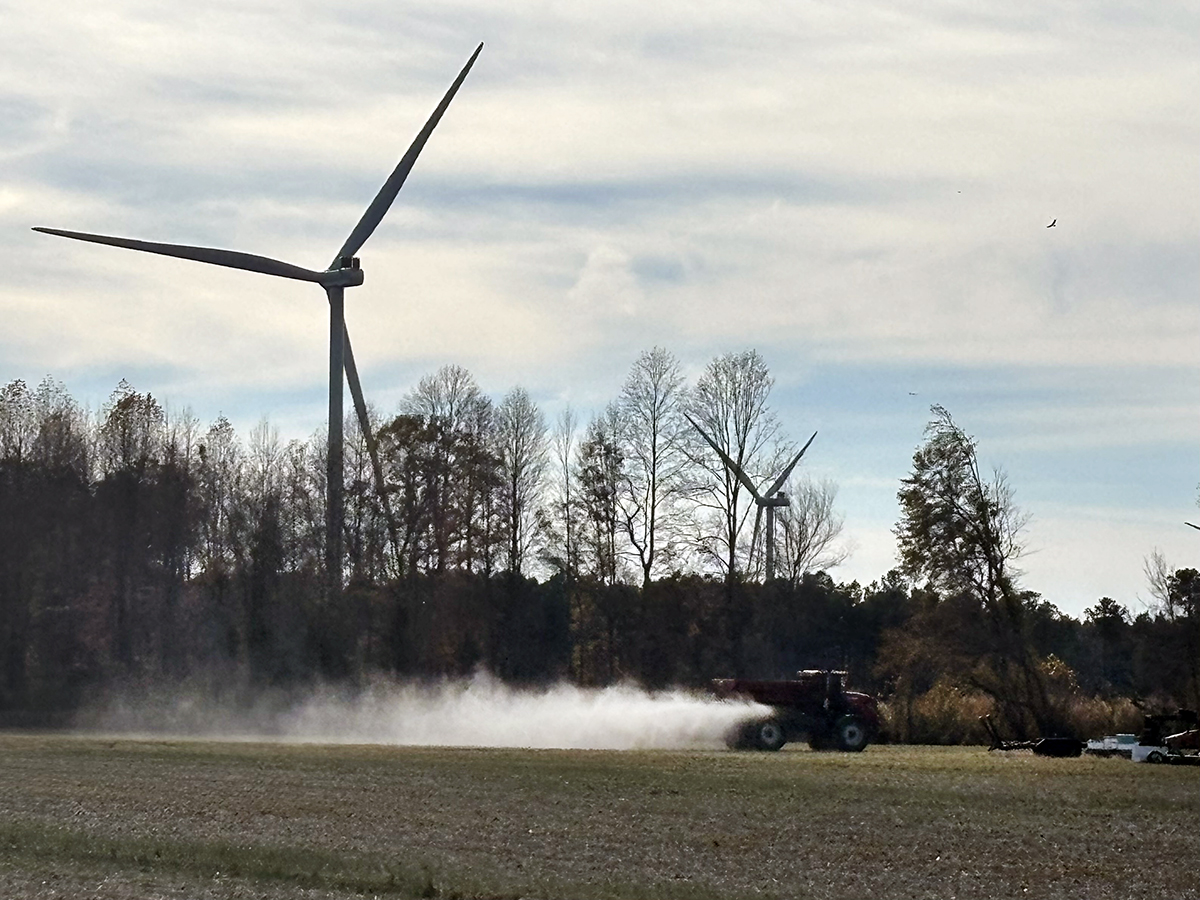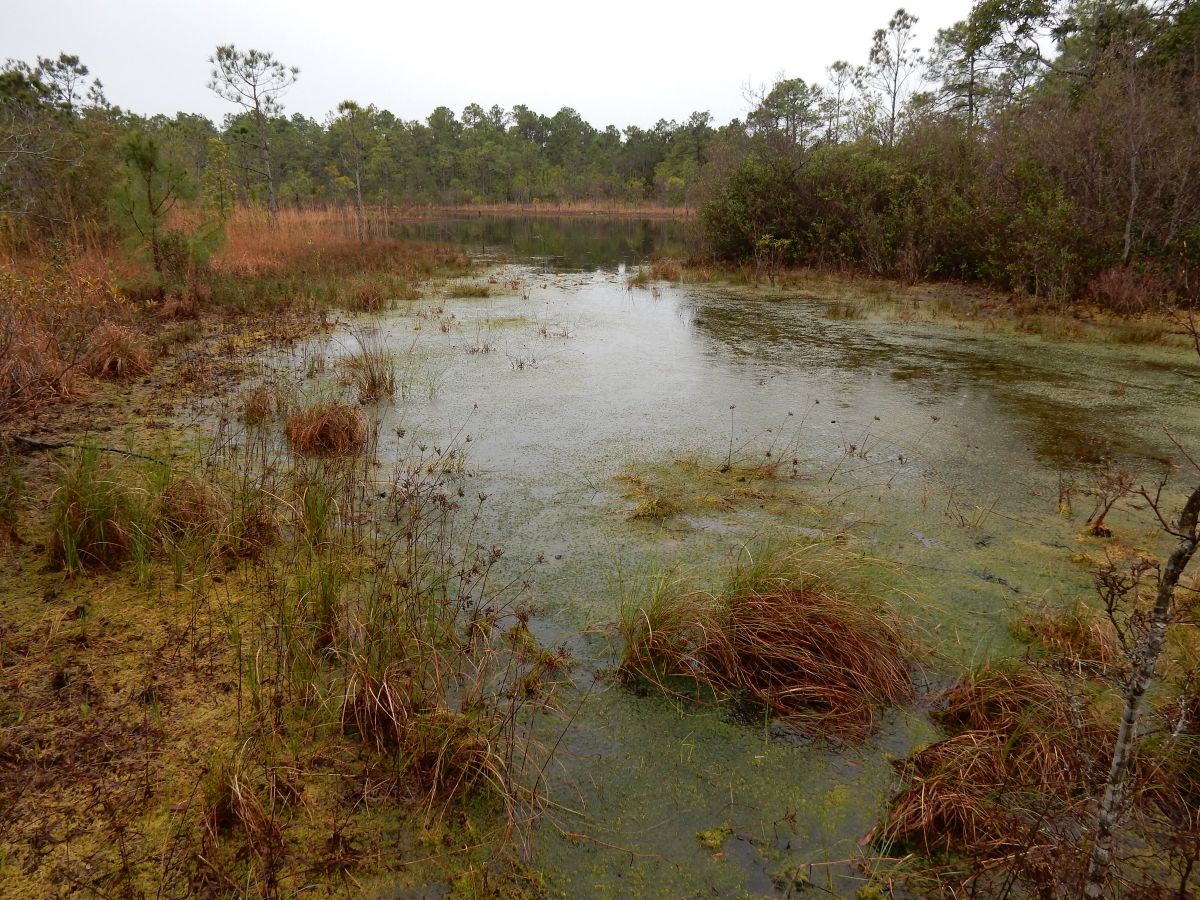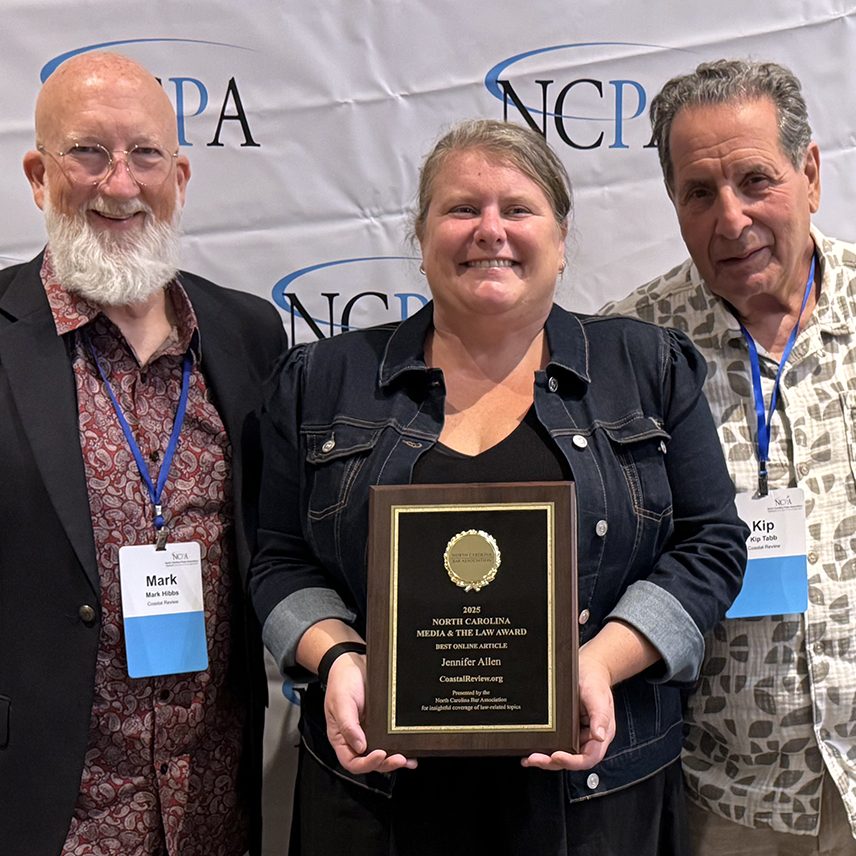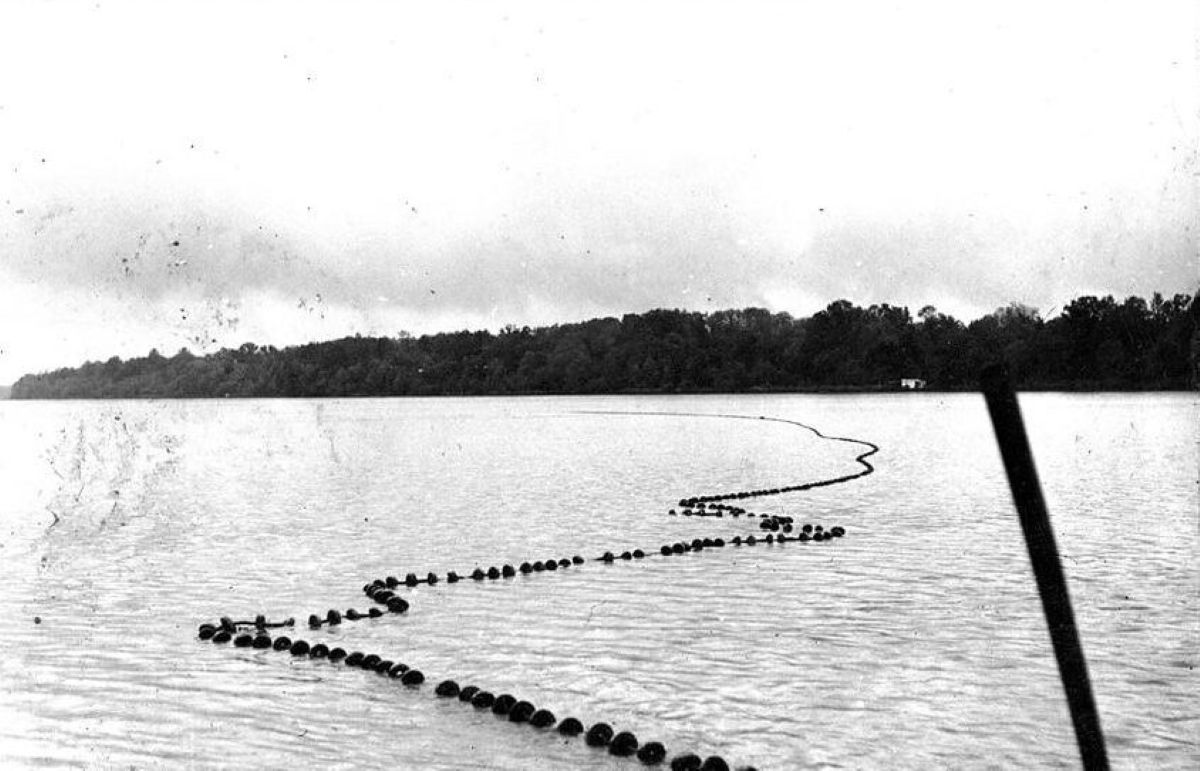
Editor’s note: Coastal Review regularly features the work of North Carolina historian David Cecelski, who writes about the history, culture and politics of the state’s coast. More of his work can be found on his personal website.
This is a special group of photographs that were taken on the Roanoke River, just west of Plymouth in the spring of 1939. Now preserved at the State Archives in Raleigh, they show the last days of two of the oldest herring seine fisheries on the North Carolina coast.
Supporter Spotlight
One of the herring fisheries, on the north side of the river, was called Kitty Hawk. The other, on the river’s south bank, was called Slade. They were owned by a local merchant, farmer and banker named W.R. “Roy” Hampton, whose family had operated the two fisheries since the first decade after the Civil War.
This is the first in a series of photo essays I’m writing on working lives on the North Carolina coast just before, during, and after the Second World War. The photographs all come from the N. C. Department of Conservation and Development Collection at the State Archives in Raleigh.
In an interview with East Carolina University graduate student Charles L. Heath Jr. in 1997, Roy Hampton’s son recalled that the fishermen at his family’s fisheries had historically come from a community called Piney Woods, also known as Free Union, a historic multiracial settlement established by free African Americans and Native Americans in the late 18th and early 19th centuries.
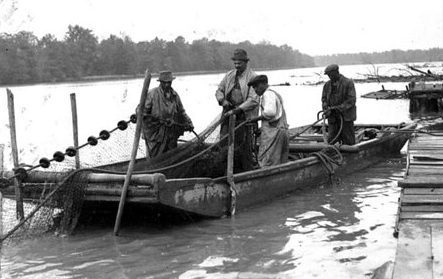
Over the years, I have written a good bit about the history of the herring fisheries on the Albemarle Sound and on two of its tributaries, the Chowan River, a blackwater stream that flows out of the Great Dismal Swamp, and the Roanoke, which flows out of the Appalachian foothills.
I imagine that the same could be said of all historians who have studied that part of the North Carolina coast in any depth.
For centuries, for millennia really, the herring fisheries were at the very heart of life on those shores.
Supporter Spotlight
Yearning to return to the waters where they began their lives, the herring left the Atlantic in the last days of winter and the first days of spring. Since time immemorial, great schools of the fish moved through Outer Banks inlets, passed into Albemarle Sound, and then continued upstream into the rivers and creeks that were their spawning grounds.
In a typical year, millions of fish, maybe billions, made the journey. By the 1840s and 1850s, when thousands of free and enslaved African Americans harvested herring in giant seines a mile or more in length, they sometimes caught 100,000 fish in a single haul and, on rare occasions, as many as half a million.
That was at the great seine fisheries on the Albemarle Sound, which were basically larger versions of the kind of fishery in these photographs from Plymouth. But the silvery little fish were there for one and all. On small creeks and streams, as well as in ditches, even the poorest souls could catch herring with a homemade bow net or a bushel basket.
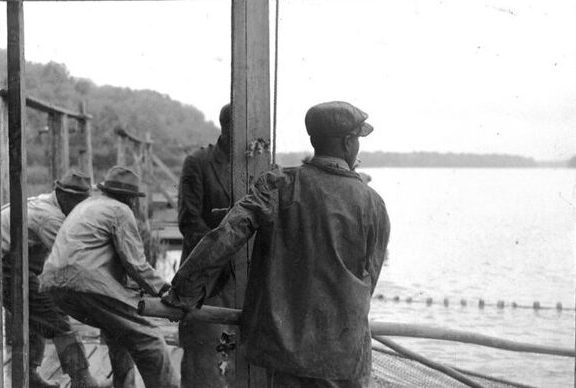
Despite all I have written about the history of the herring fisheries, these photographs from Plymouth still stood out to me. They may not be as grand and awe-inspiring as some of the photographs, drawings, and paintings I have seen of the seine fisheries that flourished on the Albemarle Sound in earlier times, but I found them at least as compelling.
In the first place, they give us a glimpse at the seine fisheries on the Roanoke. I have previously written a little on the Roanoke’s herring fisheries, but both contemporary accounts and my and the work of other historians has focused far more on the even larger and more eye-opening fisheries that flourished on the Albemarle Sound and the Chowan River in the 19th century.
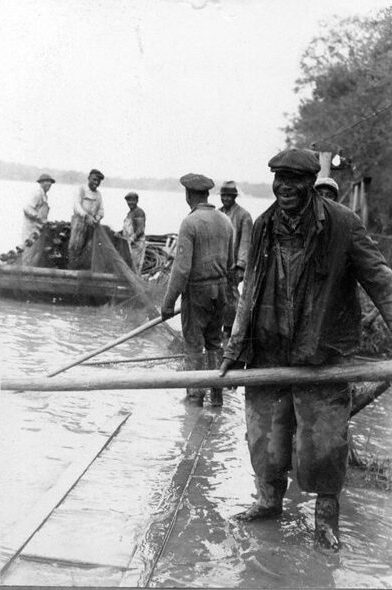
But African American fishermen, both free and enslaved laborers, were hauling herring seines on the Roanoke all that time as well. Even as late as 1896, several hundred fishermen and women operated eight seine fisheries within 10 miles of Plymouth.
Those fisheries included Kitty Hawk and Slade in Plymouth, two others 10 miles upriver in Jamesville, and four more downriver, between Plymouth and the Cashie River.
Each of those fisheries was the center of a little world. Each had its own history and its own folkways. No doubt each had its own celebrations, for there was no time of year when bellies were likely to be fuller or money more abundant.
No doubt each left its own scars too. The work was hard, the hours long — before sunup to past sundown — and the weather was often brutally cold. If ice had to be broken to make a set, ice was broken.
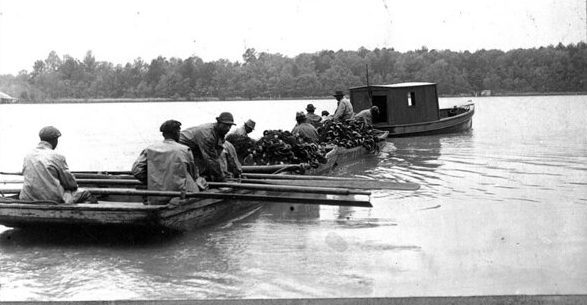
All of those fisheries were bound to the local history of slavery and plantation life, as well as, in many cases, to African American/Indian communities such as Piney Woods/Free Union.
At the very least, these photographs remind us that the Roanoke was once a place of abundance, and that the lives of its people were once bound inextricably to the natural world.
-2-
I also found these photographs compelling because of when they were taken.
The photographer, who was employed by the North Carolina Department of Conservation and Development, took the last of these photographs in the first few days of May 1939.
![Roy Hampton’s father, W. R. Hampton, was said to have run the Slade and Kitty Hawk fisheries like clockwork. During the herring and shad’s runs (roughly late February to early May), the African American fishermen and women began fishing every morning at 2 AM, in the dark of night. They worked a 17-hour day, finally taking off their oil cloth jackets and boots at 7 PM, seven days a week, They fished through bitter winter storms and freezing snow and rain, their work illuminated by torches and bonfires at night. On a typical day, the fishermen made nine hauls. At the same time, the fishery’s women workers headed and gutted tens of thousands of fish a day: wet, cold, exhausting work, though often enlivened by banter and song. The fishery workers took two breaks a day for meals and a little rest. Roy Hampton’s son remembered that his father “had a cook who cooked for them … and we furnished meat and cornbread and fish … and the guys from [Piney Woods] used to bring shallots, and they’d start a pot [of] catfish or eel or whatever in the hell they could get.” Especially on cold days, the Hamptons also kept plenty of hot coffee and bootleg liquor close at hand. Photo courtesy, State Archives of North Carolina](https://coastalreview.org/wp-content/uploads/2025/02/herring-6.jpg)
A few days later, the Kitty Hawk and Slade fisheries closed for the last time. For reasons I will discuss shortly, Roy Hampton had decided that the size of the herring catches had fallen so drastically that he could no longer justify the expense of labor, fishing gear and provisions.
The next winter, for the first time since before the Civil War, no seine fishermen made the journey down to the site of the Hampton family’s fisheries. The fishery’s women workers, the African American women who headed, gutted, and often helped salt the fish, also stayed home.
At least on that part of the Roanoke, the age of fishermen hauling the great herring seines and of raucous crowds gathering to watch them and dine on fried herring dinners was over.
Seen in that light, these photographs mark an historic moment: the end of one way of life, the coming of another, yet unknown.
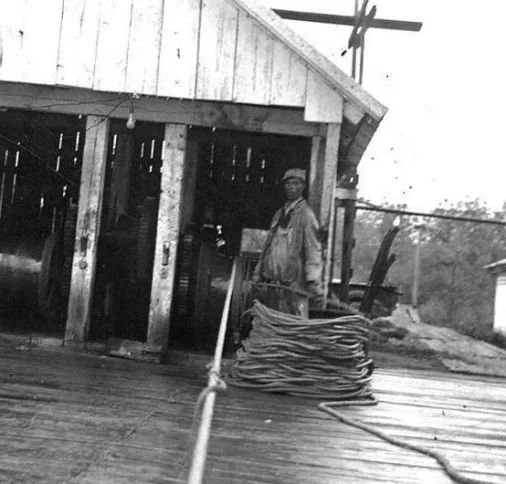
-3-
A final compelling feature of these photographs concerns the reason that Roy Hampton closed the two fisheries. He and many other fishermen were convinced that the steep decline in herring catches was due to the construction of a giant pulp mill on the Roanoke in 1937.
A division of a large, national wood and paper products corporation based in Milwaukee, Wisconsin, the North Carolina Pulp Co. located its mill just upriver of the scenes in these photographs.
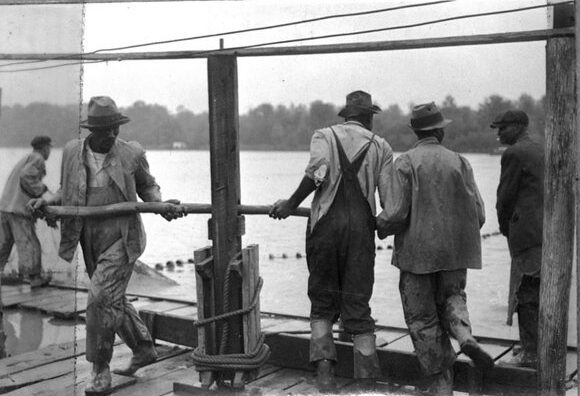
Plymouth, a small town of a couple thousands residents at that time, had never seen anything like it. The company’s smokestacks came to dominate the town’s skyline, as did the sulfurous smell of its furnaces. The company quickly bought or leased timberlands in at least five coastal counties, and thousands, many of them desperate to get off tenant farms, flocked to Plymouth to get jobs either in the mill or the company’s logging crews.
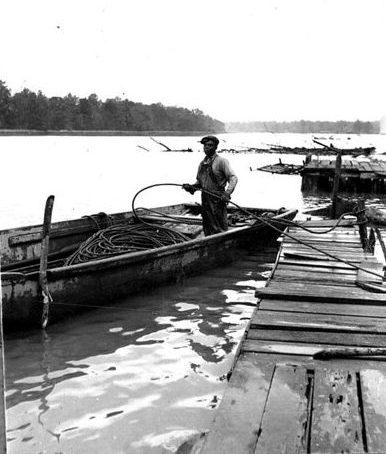
The arrival of the pulp mill made Plymouth into a “company town,” with the company being the North Carolina Pulp Co.
According to Hampton, the fishermen at the Slade and Kitty Hawk fisheries began seeing dramatic declines in their catches as soon as the pulp mill began releasing wastes into the Roanoke. The river’s waters smelled of sulfur, they claimed, and some reported fish kills.
At the end of the 1939 herring season, Hampton shuttered the Kitty Hawk and Slade fisheries. He kept them closed in 1940. Then, instead of reopening in 1941, he went to court.
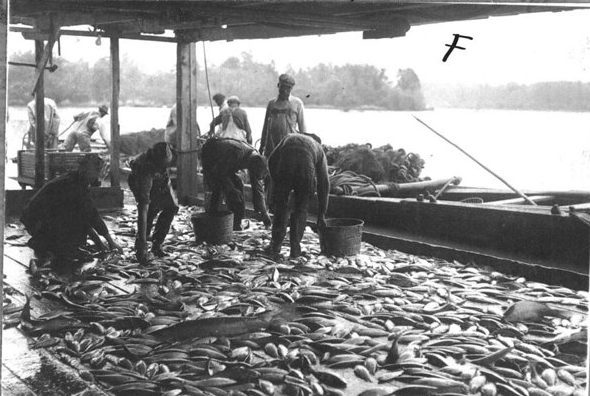
In a pair of state and federal lawsuits, Hampton accused the North Carolina Pulp Co. of dumping untreated or inadequately treated sulphates into the Roanoke, poisoning the river’s waters and destroying the herring fisheries.
In a subsequent federal lawsuit, filed in 1943, Hampton sought $30,000 in damages, an enormous sum in that day. That lawsuit referred to the pulp mill’s wastes as “a wrongful and unlawful trespass and nuisance, destroying the fish inhabiting the water” where his fisheries were located.
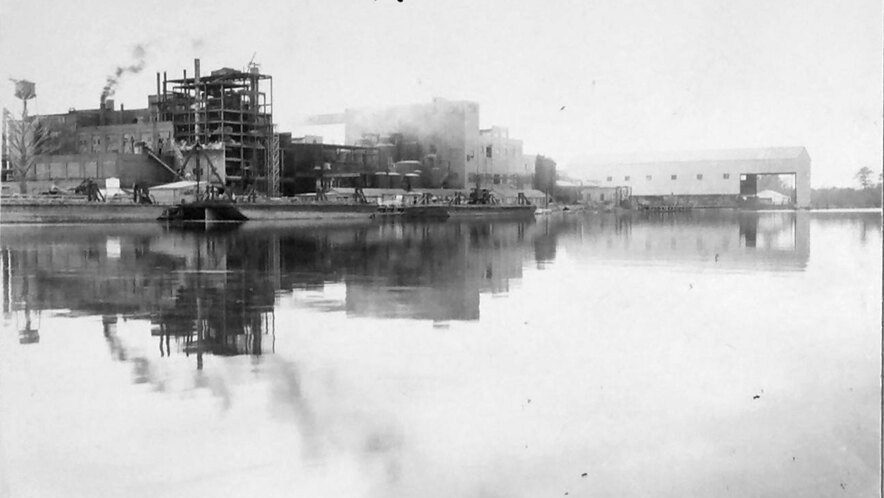
At that time, Hampton could do little else. Prior to the Second World War, no state agency had the authority to regulate industrial pollutants or to set standards for pollutants in our waterways.
Federal law also provided very little meaningful regulation of pollutants.
That did not begin to change until the U.S. Congress passed the Federal Water Pollution Act of 1948.
Even then, federal regulation of water quality had little teeth. That did not change until environmental activists succeeded in pushing the Nixon Administration to create the Environmental Protection Agency in 1970 and prompted Congress to pass the Clean Water Act of 1972.
If the Trump Administration lives up to its promises, the EPA will be dismantled over the next four years. The Clean Water Act of 1972 may or may not continue to exist in name, but the protections that it has provided to our rivers and streams, to our fisheries, and to public health will disappear.
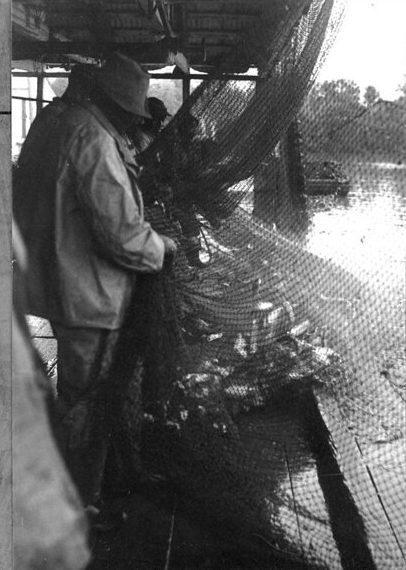
-4-
During the Second World War, Roy Hampton’s attorneys had some success in court, winning on issues of standing at the North Carolina Supreme Court and at the U. S. Court of Appeals in Richmond. For a summary of those court rulings, see Hampton v. N. C. Pulpwood Co.
However, the case does not seem to have gone any further. That may have been because of legal rulings in the lower courts, but it may also have been simply that Hampton lost heart and eventually accepted that the pulp mill, not the fisheries, was Plymouth’s future.
-5-
One by one, the last of the Roanoke’s herring seine fisheries closed. Slade and Kitty Hawk were among the last. I am aware of only one other seine fishery that was still in operation at the end of the Second World War.
That seine fishery was in Jamesville, seven miles upriver of the Kitty Hawk and Slade fisheries.
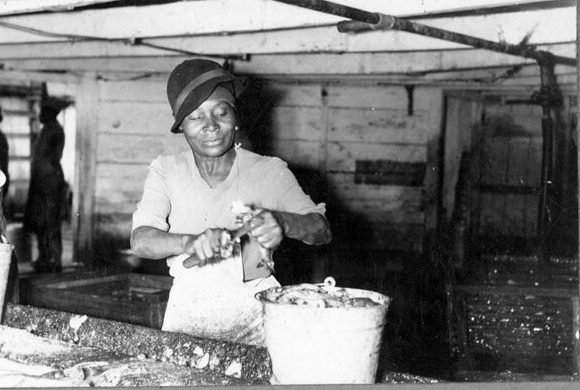
According to an April 16, 1950, story in the Raleigh News & Observer, that fishery was owned by C.C. Fleming, a businessman and political leader in Jamesville. Gus Hooper, a veteran African American waterman, was the head fisherman and the captain of the fishery’s seine boat.
The Jamesville fishery was still in business in 1955. At that time, the News & Observer April 24, 1955, referred to the seine fishery as “the only one of its type on the entire eastern seaboard.”
That herring season may have been the last for Fleming’s seine fishery. I cannot find any historical references to it after 1955.
Seines versus Bow Nets
I should note that many of the Roanoke’s herring fishermen did not shed tears over the demise of the seine fisheries.
Historically, many of the river’s people believed, probably with good reason, that the big seine fisheries took more than their fair share of herring — and shad, rockfish, perch and other fish to boot. In those people’s eyes, the seine fisheries deprived those of lesser means of food for their dinner tables.
As UNC-Chapel Hill professor Harry Watson showed in a splendid 1996 article in the Journal of American History, the more prosperous owners of seine fisheries and those who lived more hand-to-mouth had battled over access to the migratory fish on that part of the North Carolina coast since the 18th century.
They continued to do so even in the dying days of seine fishing.
C. C. Fleming’s seine fishery in Jamesville was a case in point. In 1952-53, Fleming used his political influence to persuade state legislators to give him a virtual monopoly over herring fishing on a mile-long stretch of the Roanoke.
-6-
Though an ominous sign of things to come, the closing of the seine fisheries in Plymouth and Jamesville did not mean the end of herring fishing on the Roanoke River.
For another half century, the arrival of the herring on the Roanoke remained a festive event. Up and down the river, people continued to catch herring. They just did not use the kinds of large seines, such as the ones in our photographs, that only made financial sense if there was a greater bounty of herring to be had.
Instead, they used a wide variety of lesser gear, including dragnets, bow nets, and even a device called a “fish wheel.”
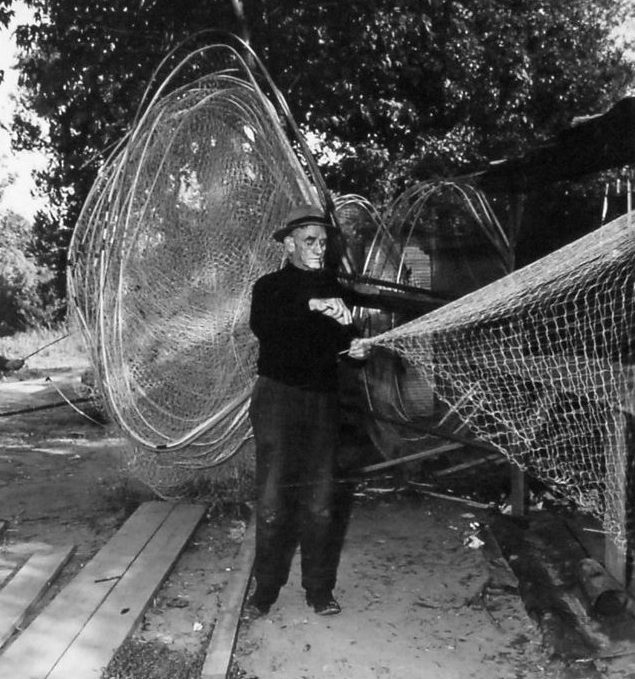
Over that time, local festivals still celebrated the arrival of the herring. Churches and other community groups marked the season with fried herring dinners. Fresh and salt herring remained staples in local homes.
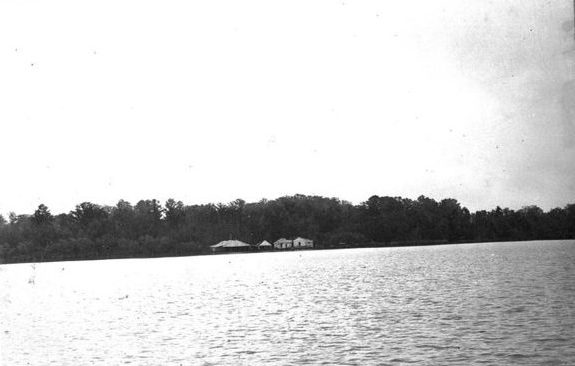
The herring’s spawning runs continued to decline however. For a time, a herring fishery and cannery was still flourishing 25 miles to the north of Plymouth, on the Chowan River, but even it collapsed in the 1990s.
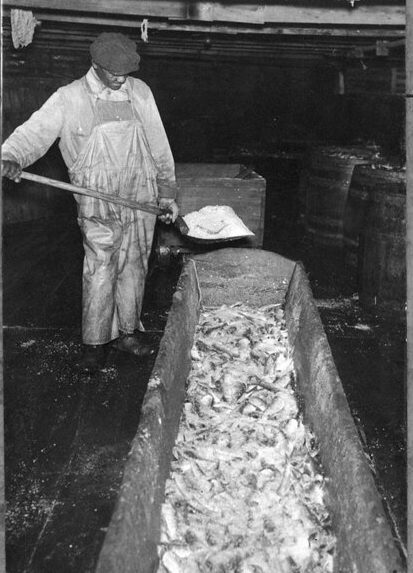
In response, fishery regulators eventually took the drastic step of banning all herring fishing on North Carolina’s inland waters. They hoped that the herring population would recover some of its health if there was a period of time without any commercial or recreational harvest of the fish.
For the first time in thousands of years, no herring were legally caught on the Albemarle or its tributaries, including the Roanoke, beginning with the spring spawning runs of 2007.
That ban is still in effect. We are still waiting for our waters to be restored. We are still waiting for our rivers to know again an abundance of life. And we are still waiting for the herring to come back home.
-End-

